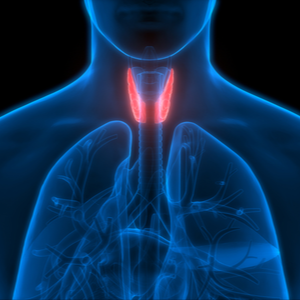
What is pharyngeal carcinoma?
Pharyngeal carcinoma is also colloquially known as throat cancer. This is a cancer of the throat, the so-called pharynx, which in over 90 percent of all cases is caused by a squamous cell carcinoma that originates from the mucous membrane cells. Doctors distinguish between carcinoma of the pharynx (hypopharynx) and carcinoma of the mouth and nasopharynx (oropharynx and nasopharynx). A pharyngeal carcinoma can be manifested by thick lymph nodes in the neck. These swell due to the spread of the tumour. In most cases, however, the pharyngeal carcinoma is already in a late stage of cancer.
What medical subdivisions are there?
Doctors divide the pharynx into three sections:
- Upper section(nasopharynx or epipharynx): starting behind the nasal cavity and ending above the soft palate
- Middle section:(mesopharynx or oropharynx): belonging to the mouth and ending at the transition to the larynx. In addition to the posterior wall of the pharynx, this includes the base of the tongue, the pharyngeal tonsils and the anterior surface of the soft palate.
- Lower section:(hypopharynx) lowest part of the pharynx beginning at the point where the airway and foodway separate and ending behind and to the side of the laryngeal inlet
What risk factors can promote the development of pharyngeal carcinoma?
While a hypopharynx and an oropharynx are mainly caused by smoking, excessive alcohol consumption and an infection with the human papilloma virus (HPV 16 and 18), the nasopharynx occurs more frequently in southern China, North Africa and Alaska. The Pfeiffersche glandular fever and/or the Epstein-Barr virus (EBV virus) can play a predominant role in the development of the nasopharynx.
What are the symptoms of pharyngeal carcinoma?
In almost 50 per cent of all cases, pharyngeal carcinoma is not diagnosed until it has metastasised to the lymph nodes of the neck, resulting in swelling of the lymph nodes. Swollen lymph nodes can be a symptom of cancer, especially if they occur on one side and are painless.
People who suffer from nasopharyngeal carcinoma often complain of nosebleeds or persistent rhinitis. They may also suffer from chronic inflammation of the sinuses and headaches. These symptoms are caused by obstructed nasal breathing. If there is also a lack of ventilation in the middle ear (tubal dysfunction), there may be effusions in the middle ear, which are accompanied by hearing loss or a disturbing ringing in the ears (tinnitus). If the nasopharyngeal carcinoma is in an advanced stage and has already grown into the adjacent skull base, facial pain may occur.
An advanced stage oropharyngeal carcinoma, on the other hand, manifests itself as neck and/or ear pain and/or difficulty swallowing. If a tongue tumour is present, the tongue's mobility is increasingly restricted and the patient complains of slurred speech. If the tumour is large and located at the side of the pharynx, the patient will experience restricted mouth opening (lockjaw or trismus). Other signs of oropharyngeal carcinoma are noticeable bad breath and/or bleeding in the mouth and throat.
A hypopharyngeal carcinoma manifests itself in the early stages through rather unspecific complaints. Only after a certain size can a hypopharyngeal carcinoma cause a foreign body sensation and/or lead to swallowing difficulties and excessive salivation. In the case of hypopharyngeal carcinoma, the tumour often spreads to neighbouring structures. If this also affects the larynx, the vocal cord movement can be restricted and hoarseness can occur. Hypopharyngeal carcinoma is usually diagnosed very late, which is why unwanted weight loss is a common symptom.
How is pharyngeal carcinoma diagnosed?
If a pharyngeal carcinoma is suspected, it should be diagnosed by an ear, nose and throat (ENT) specialist. He or she will first examine the oral cavity, the nasal cavity and pharynx as well as the larynx and the ears with the help of a small mirror (mirror examination). In most cases, a pharyngeal carcinoma can already be detected by this examination. In addition, an endoscopy or a blood test may be ordered.
How is pharyngeal carcinoma treated?
Small pharyngeal carcinomas in particular can usually be cured without any problems. However, since the tumours are already in an advanced stage when they are diagnosed, the pharyngeal carcinoma has already spread metastases by that time. The aim of treatment is then to maintain the patient's quality of life and enable them to continue to eat, drink, breathe and speak normally.
Doctors make a basic distinction between the treatment of the respective forms of carcinoma. While both oropharyngeal and hypopharyngeal carcinoma can be surgically removed in some cases, or alternatively a combination of chemotherapy and radiotherapy is used, surgery is not an option for nasopharyngeal carcinoma due to its localisation. Instead, a nasopharynx is treated with radiotherapy in combination with chemotherapy. Hypopharyngeal and oropharyngeal cancer mainly affects men with an average age of 60.
